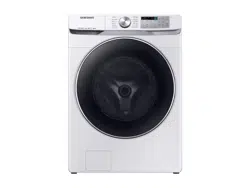Documents: Go to download!
User Manual
- User Manual - (English, Spanish)
- Energy Guide - (English)
- What’s included
- Operations
- Maintenance
- Troubleshooting
Table of contents
Owner Manual Washer & Dryer
What’s included
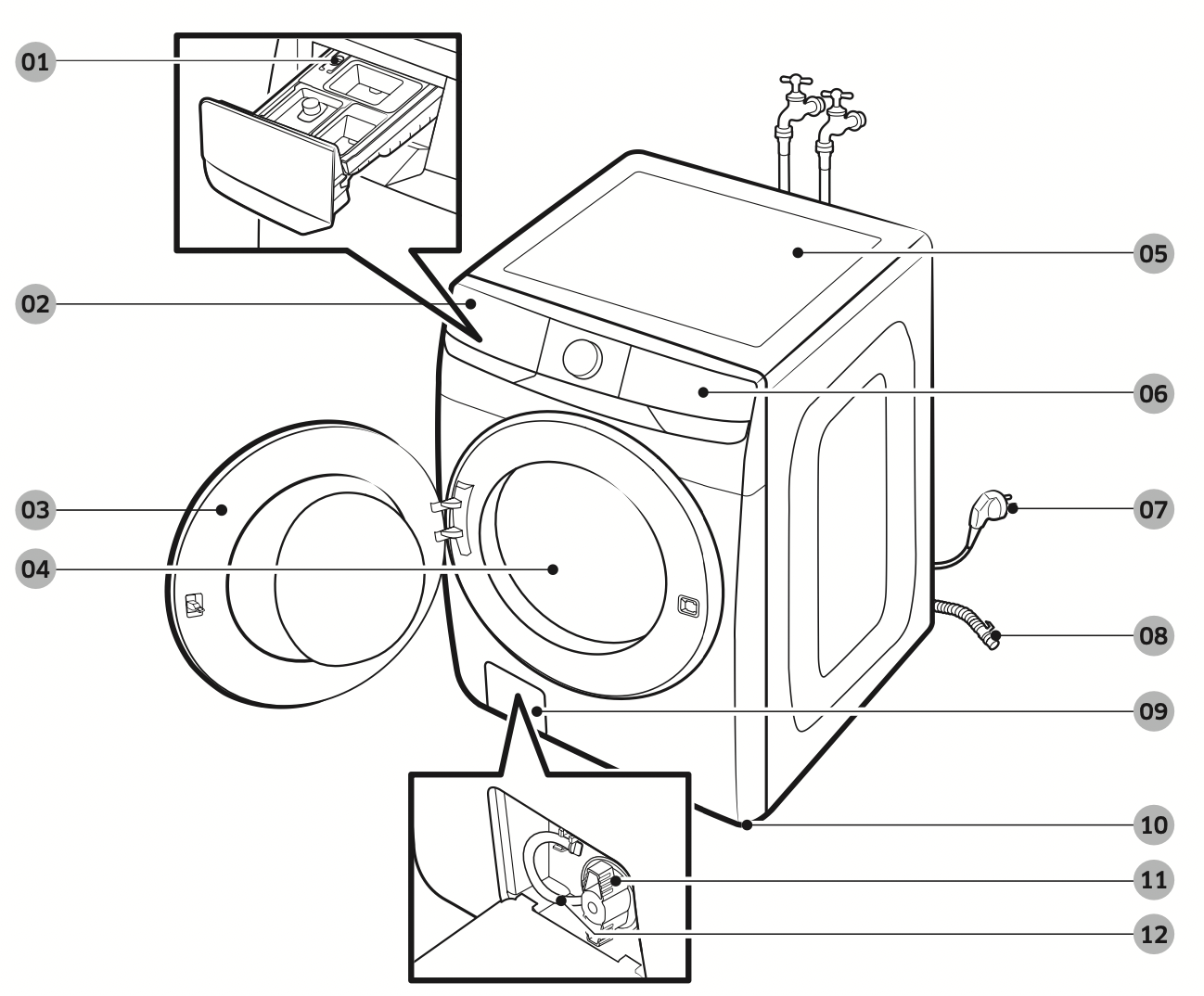
- Release lever
- Detergent drawer
- Door
- Drum
- Worktop
- Control panel
- Power plug
- Drain hose
- Filter cover
- Leveling feet
- Pump filter
- Emergency drain tube
Operations
WARNING: To reduce the risk of fire, electric shock, or injury to persons, read the Safety information before operating this appliance.
Control panel

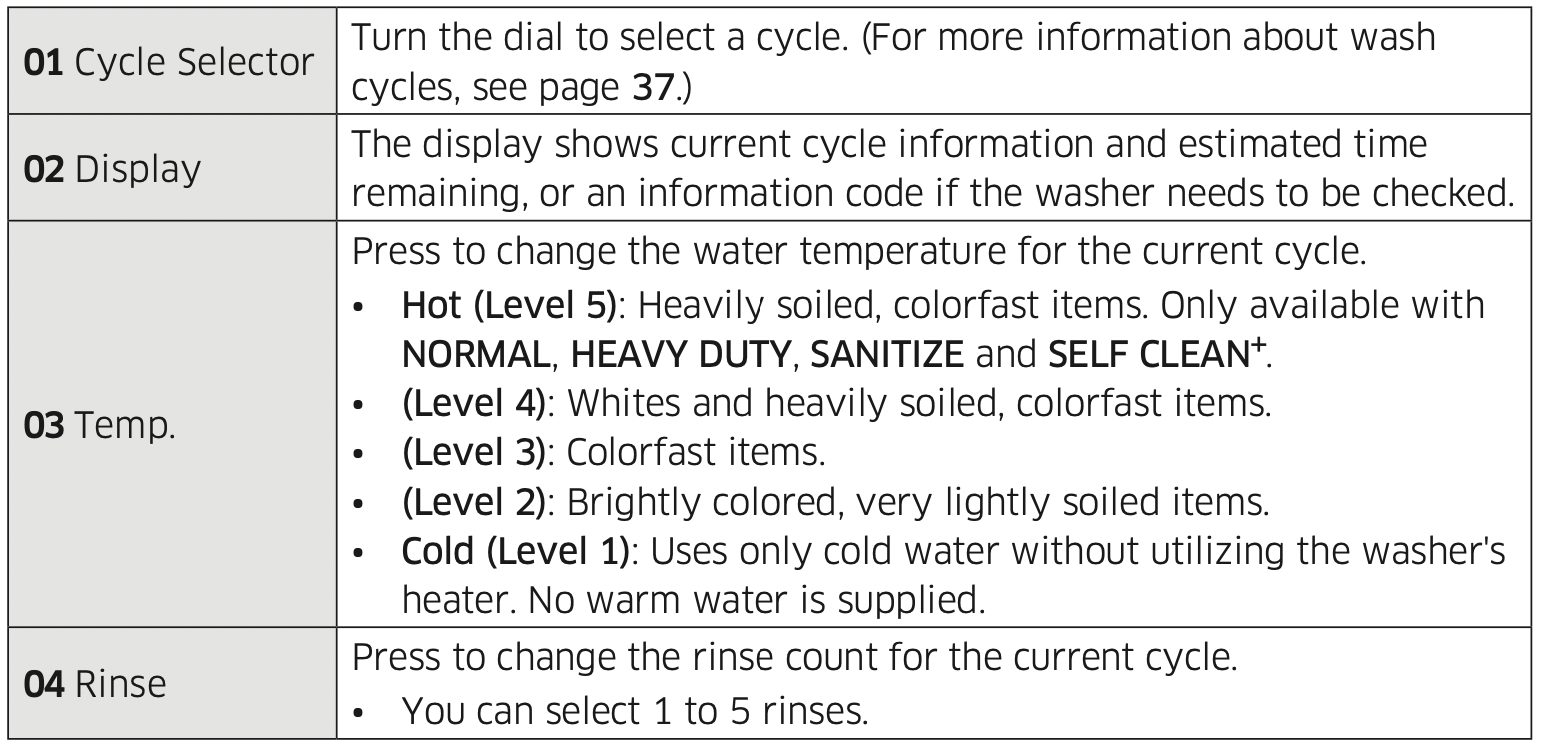
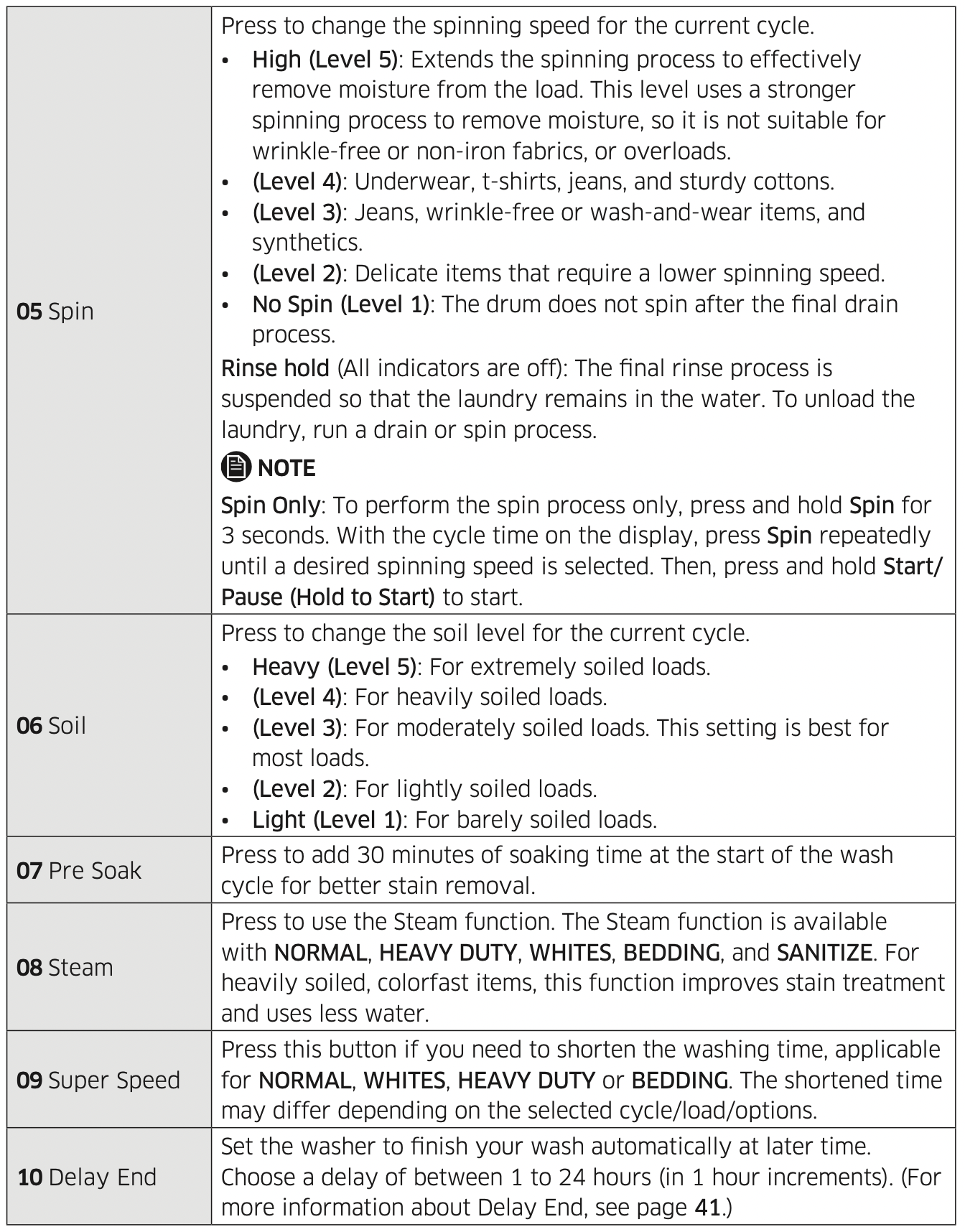
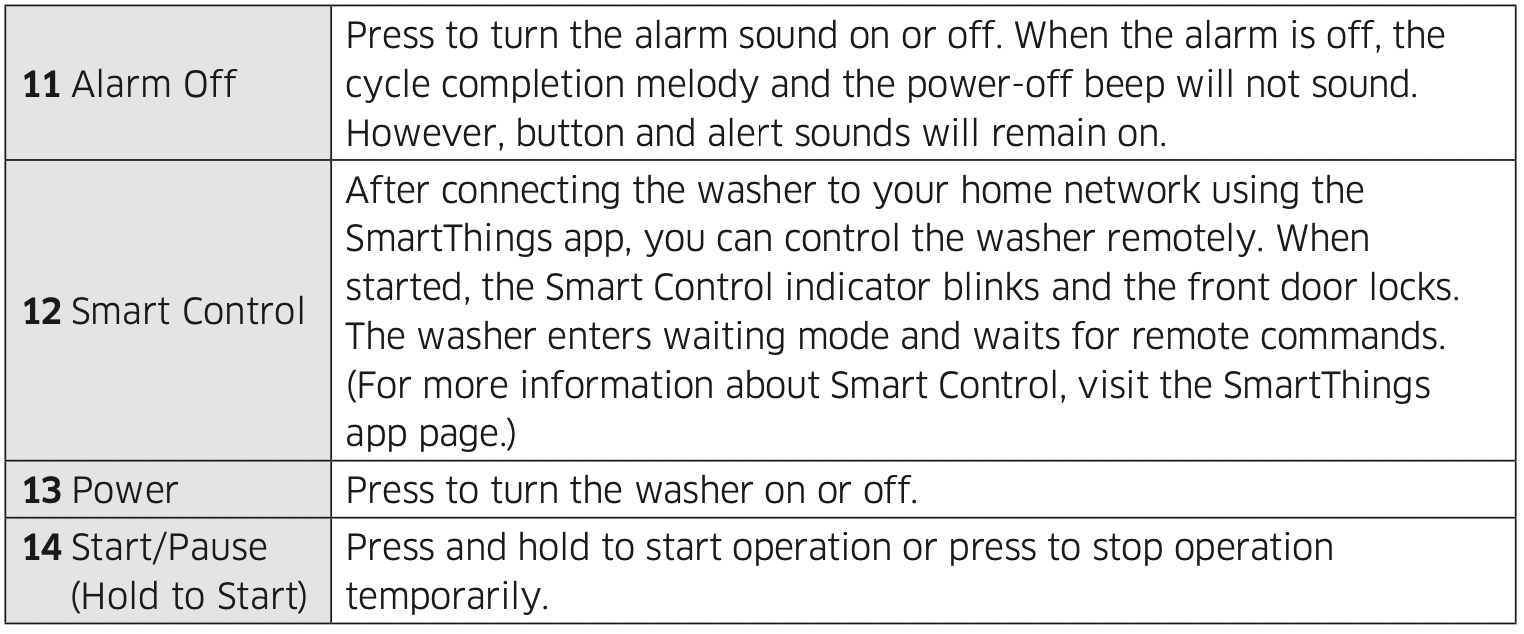
Icon description
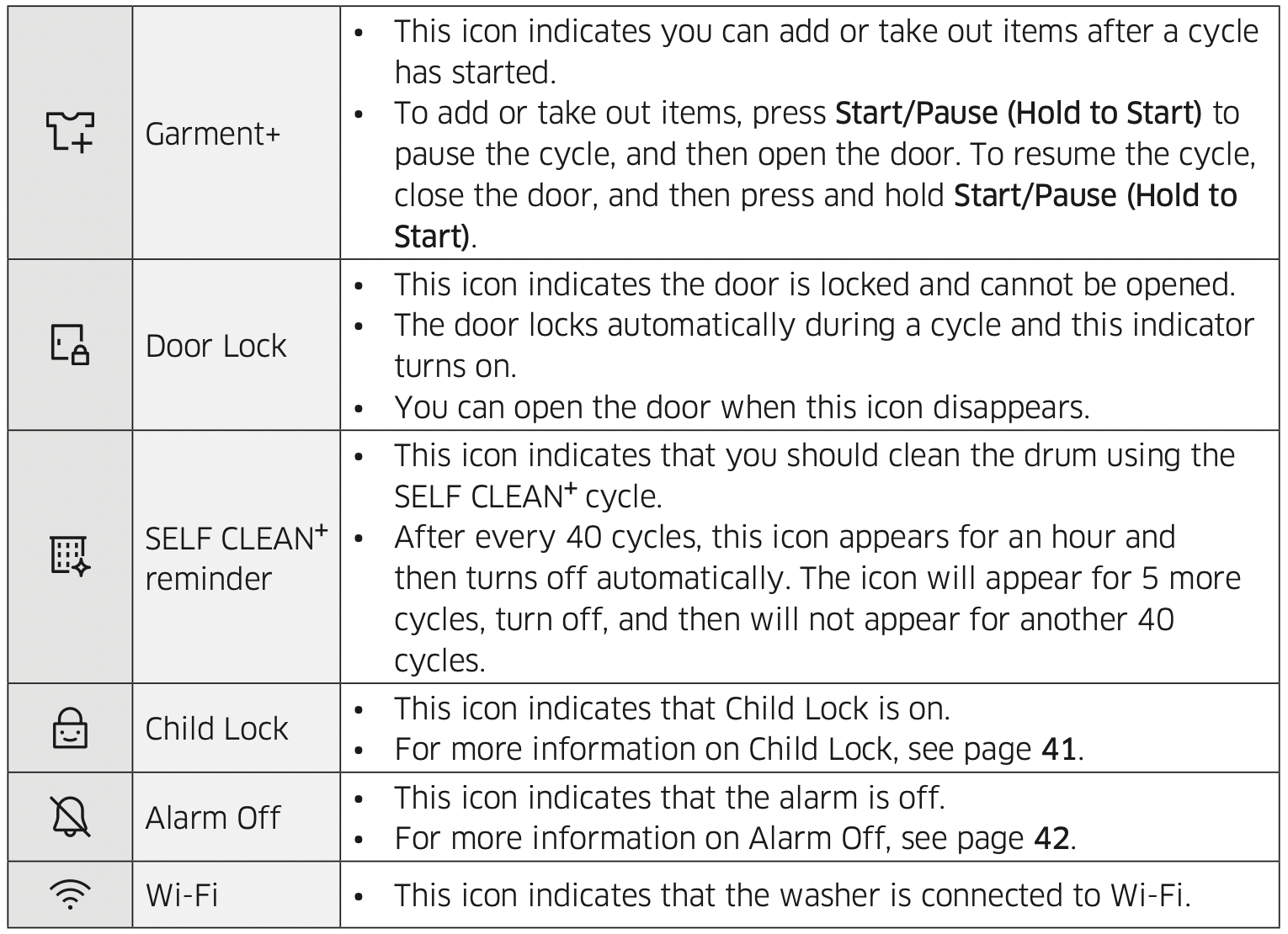
Simple steps to start

- Press Power to turn on the washer.
- Turn the Cycle Selector to select a cycle.
- Change the cycle settings (Temp., Rinse, Spin, and Soil) as necessary.
- Select desired options as necessary.
- Press and hold Start/Pause (Hold to Start).
To change the cycle during operation
- Press Start/Pause (Hold to Start) to stop operation.
- Select a different cycle.
- Press and hold Start/Pause (Hold to Start) again to start the new cycle.
WARNING: Do not place anything on top of your washer while it is running.
Cycle overview
NOTE: The washer detects the weight of the items and automatically adjusts the optimal water level, washing time, rinse counts, and spin counts. (This may not be applicable on some cycles.)
Standard Cycles

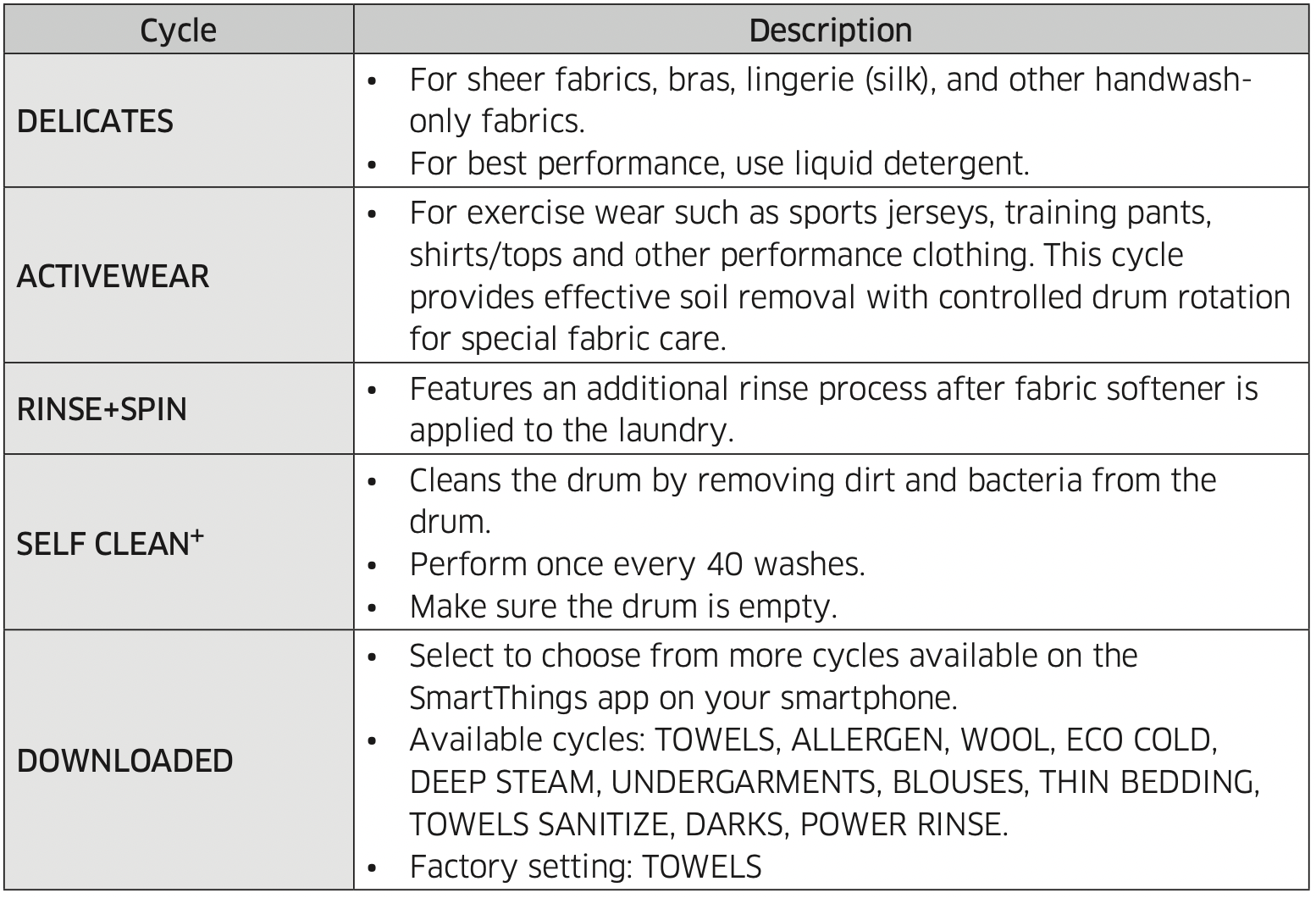
Steam Cycles
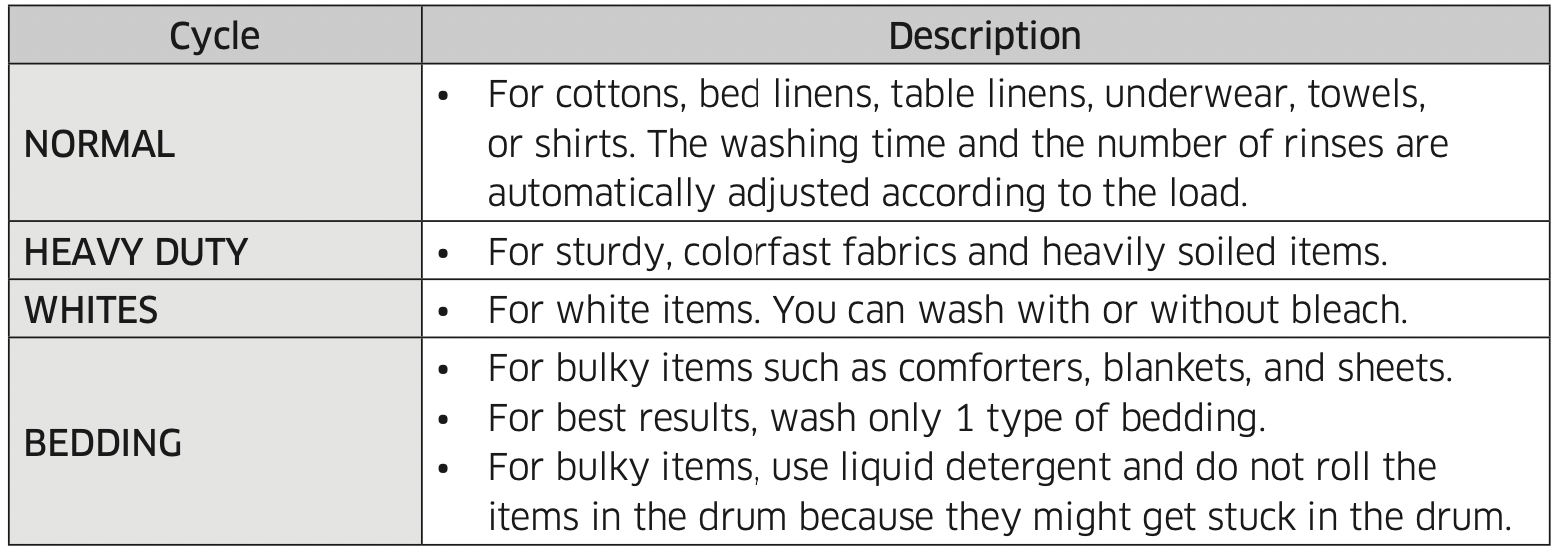

Cycle chart
Use this chart to set the best cycle and options for your laundry.
NOTE:

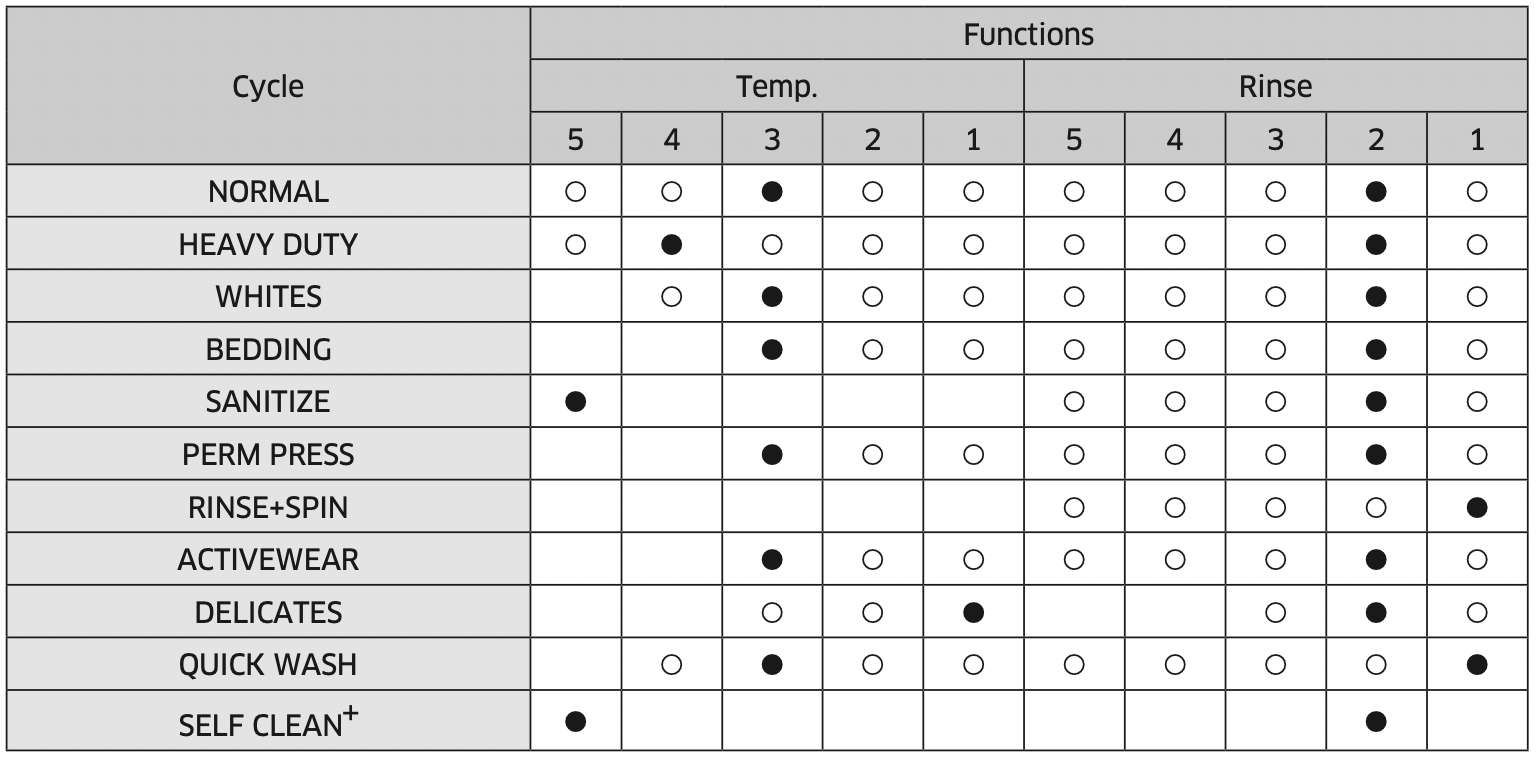
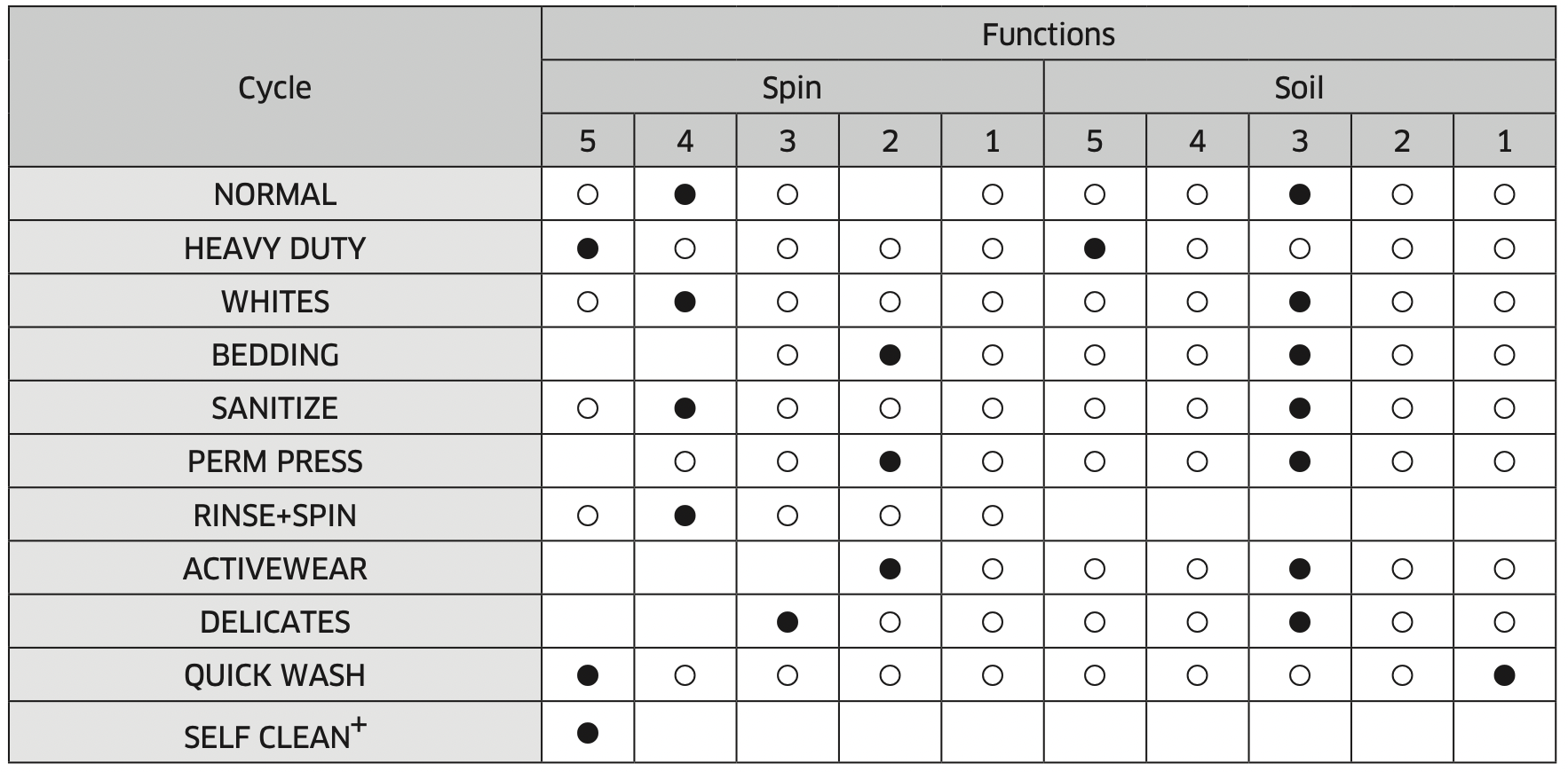
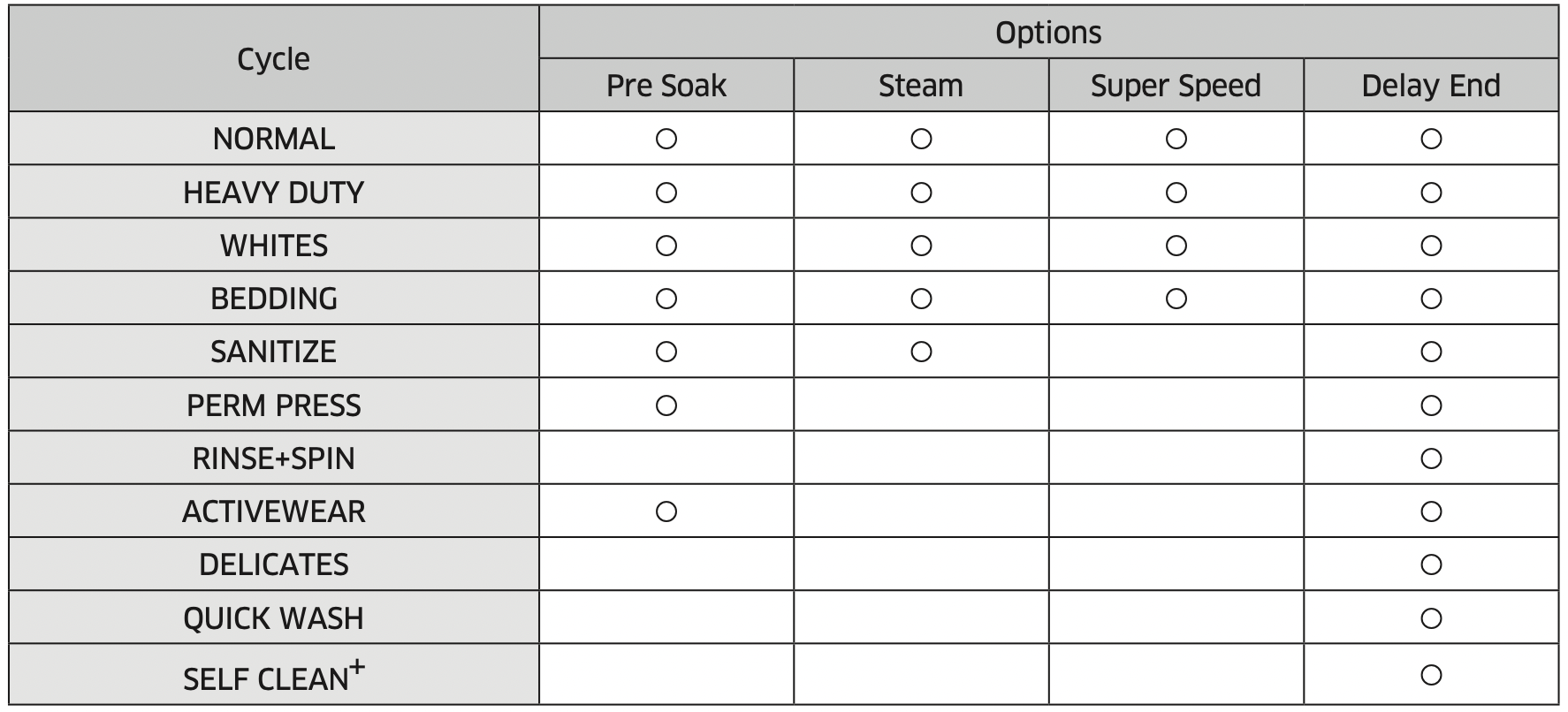
Special features
Delay End
You can set the washer to finish your wash automatically at a later time by choosing a delay of between 1 to 24 hours (in 1 hour increments). The hour displayed indicates the time the wash will finish.
- Select a cycle. Then, change the cycle settings if necessary.
- Press Delay End repeatedly until a desired end time is set.
- Press and hold Start/Pause (Hold to Start).
- To cancel Delay End, restart the washer by pressing Power.
Real-life case
You want to finish a two-hour cycle 3 hours from now. To do this, you add the Delay End option to the current cycle with a 3-hour setting, and then press and hold Start/Pause (Hold to Start) at 2:00 pm. The washer starts operating at 3:00 pm and ends at 5:00 pm. Provided below is the time line for this example.

ATC (Auto Temperature Control)
ATC enables the washer to control water temperatures in each washing cycle using the internal thermistor. It is designed to maintain certain washing temperatures for best results.
NOTE
- If you select NORMAL or HEAVY DUTY, you may notice the washer supplying cold water. This is normal because the machine is designed to reduce power consumption. In these cycles, the water temperature for Level 5 is similar to bath-water temperatures, and Level 3 is similar to comfortable swimming pool temperatures.
- To wash clothes at a specific temperature, you must choose a different cycle first.
Child Lock 
The Child Lock function locks the washer door to prevent children from climbing into and suffocating inside the drum.
To activate Child Lock
- Press and hold both Temp. and Rinse for 3 seconds. Then, press and hold Start/Pause (Hold to Start) to activate. The door locks, and the Child Lock indicator turns on.
To deactivate Child Lock temporarily
- You can deactivate Child Lock temporarily for 1 minute. To do this, press and hold both Temp. and Rinse for 3 seconds. The door is unlocked for 1 minute and the Child Lock indicator blinks.
NOTE
- If you open the door 1 minute after deactivating Child Lock, an alarm sounds for up to 2 minutes.
- If you close the door within 2 minutes, the door locks and Child Lock is reactivated. If you do not close the door or the door is not properly closed, the alarm keeps sounding for 2 minutes.
- To add laundry after activating Child Lock, deactivate Child Lock or restart the washer.
To cancel Child Lock
- Press and hold both Temp. and Rinse for 6 seconds. The door unlocks, and the Child Lock indicator turns off.
Alarm Off 
You can turn the alarm sound on or off. When the alarm is off, the cycle completion melody and the power-off beep will not sound. However, the other sounds stay active.
- Press Alarm Off to turn the alarm on or off.
- Your setting will be kept even after you turn off and then restart the appliance.
DOWNLOADED cycle
You can choose from more cycles available on the SmartThings app on your smartphone.
- On your smartphone, select the DOWNLOADED cycle.
You can choose from TOWELS, ALLERGEN, WOOL, ECO COLD, DEEP STEAM, UNDERGARMENTS, BLOUSES, THIN BEDDING, TOWELS SANITIZE, DARKS, and POWER RINSE. - Press Power on your washer.
- Turn the Cycle Selector to DOWNLOADED.
- Press and hold Start/Pause (Hold to Start).
Bixby
Bixby is a Samsung’s intelligence platform, and you can control the product with your voice. To use the voice command feature, you must connect the product with the SmartThings app on your phone. For products that do not recognize voice directly from the product, you can use the Bixby on your smartphone to control some of the functions of your product after connecting to the app.
Maintenance
Keep the washer clean for best performance and to lengthen its life cycle.
WARNING: Certain internal parts are intentionally not grounded and may present a risk of electric shock only during servicing. Service personnel – Do not contact the following parts while the appliance is energized: Control board, heat sink, motor, inlet valve and pump.
Self Clean+
Certain usage and environmental conditions may result in some residue build-up or odor in the washer drum. To prevent this build-up of residue or odor causing bacteria and keep your washer drum fresh and clean, perform the SELF CLEAN cycle at least once a month or every 40 cycles. Perform the recommended procedure below when using the SELF CLEAN cycle.
- Remove all items from the washer drum and ensure the drum is empty. Laundry left in the drum during the SELF CLEAN cycle may be damaged.
- Press Power to turn on the washer.
- Turn the Cycle Selector to SELF CLEAN .
- Press and hold Start/Pause (Hold to Start).
NOTE
- The water temperature for SELF CLEAN is defaulted to Hot. This temperature cannot be changed.
- In the case where residue is present in the washer drum, add liquid chlorine bleach to the MAX level line in the main-wash compartment before starting the SELF CLEAN cycle. Do not add the liquid chlorine bleach to the bleach compartment (This is only the case for SELF CLEAN cycle).
- Do not exceed the max line. Do not use or mix any other detergent or chemicals during the SELF CLEAN cycle. If necessary, run a RINSE+SPIN cycle after the SELF CLEAN cycle has completed to help remove any remaining residue.
CAUTION: If there is chlorine bleach left in the washer drum for an extended period of time, rust can occur.
SELF CLEAN reminder (  )
)
- After 40 washing cycles, the SELF CLEAN LED reminder icon and the SELF CLEAN cycle LED will blink on the control panel for an hour and then turn off automatically.
- The reminder will appear on the control panel for 5 additional consecutive cycles before turning off. The next reminder will not appear until another 40 cycles have been completed.
Smart Care
To enable this function, you must first download the Samsung Laundry app from the Play Store or the App Store and install it on a mobile device that has a camera function. The Smart Care function has been optimized for Galaxy and iPhone mobile devices (applicable models only).
- When the washer detects an issue to check, an information code appears on the display. To enter Smart Care mode, press and hold Soil for 3 seconds.
- The washer starts the self-diagnosis procedure and displays an information code if a problem is detected.
- Run the Samsung Laundry app on your mobile device, and then tap Smart Care.
- Put the mobile device close to the washer’s display so that the smartphone camera and the washer face each other. The information code will be recognized automatically by the app.
- When the information code is recognized correctly, the app provides detailed information about the problem with applicable solutions.
NOTE
- The function name, Smart Care, may differ depending on the language.
- If the washer's display reflects light, the app may fail to recognize the information code.
- If the app fails to recognize the information code, you can enter the code manually on the app.
Emergency drain
In case of a power failure, drain the water inside the drum before taking out the laundry.
- Turn off the washer, and then unplug the power cord.
- Gently press the top area of the filter cover to open.
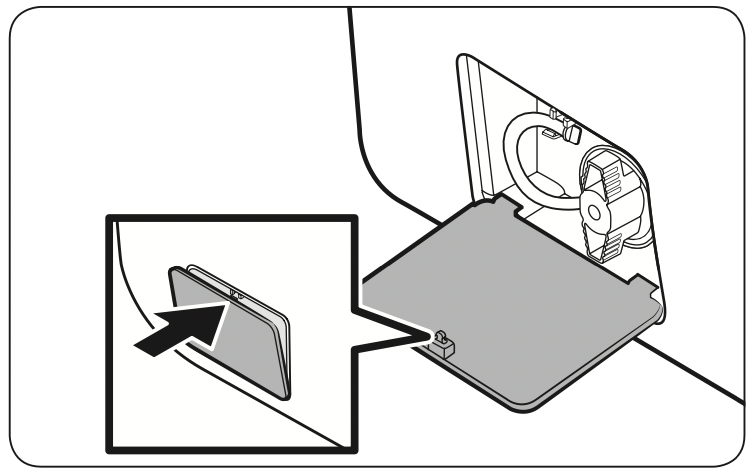
- Put an empty, spacious container around the cover, and stretch the emergency drain tube to the container while holding the tube cap (A).
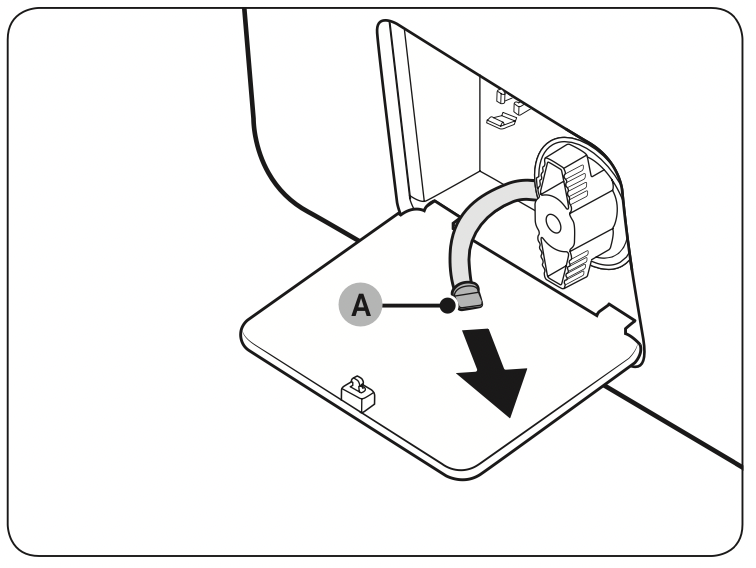
- Open the tube cap and let water in the Emergency drain tube (B) flow into the container.
- When done, close the tube cap, and reinsert the tube. Then, close the filter cover.

NOTE: Use a spacious container because the water in the drum may be more than expected.
Cleaning
Surface of the washer
Use a soft cloth with a nonabrasive household cleaner. Do not spray water onto the washer.
Mesh filter
Clean the mesh filter of the water hose once or twice a year.
- Turn off the washer, and then unplug the power cord.
- Close the water tap.
- Loosen and disconnect the water hoses from the back of the washer. Cover the each hose with a cloth to prevent water from gushing out.
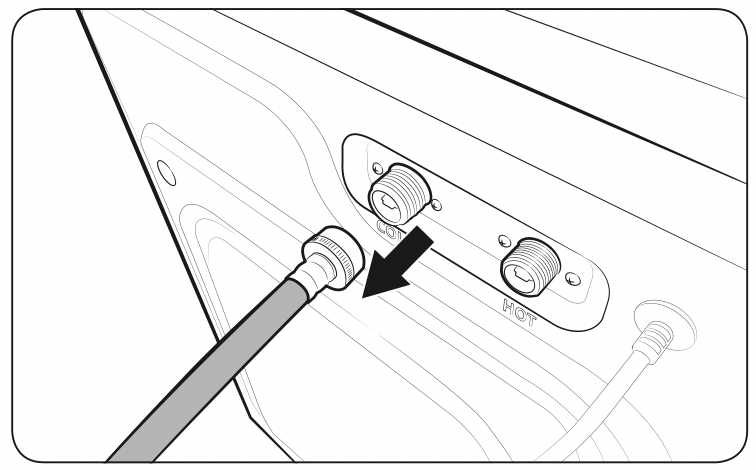
- Use pliers to pull out the mesh filter from the inlet valves.
- Thoroughly clean the mesh filters in water.
- Completely dry the mesh filters. Do not dry in direct sunlight.
- Reinsert the mesh filters, and then reconnect the water hoses.
- Open the water taps.
See other models: SM-A716UZKNUSC NK24M1030IS/UR SM-A015AZKBATT EP-P3105TBEGUS SM-N960UZPASPR
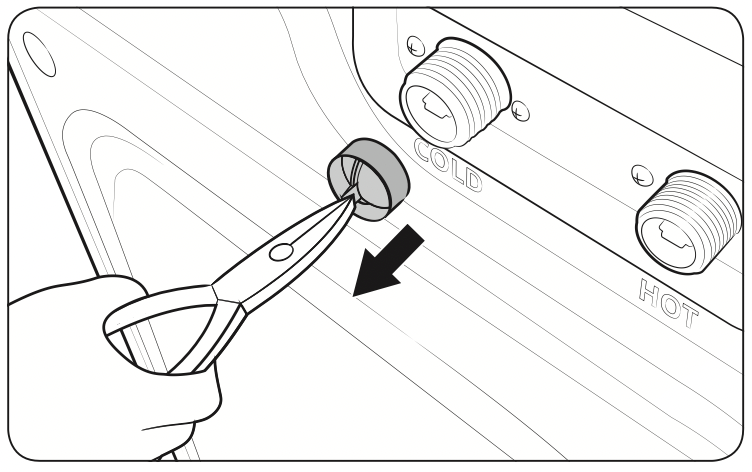
NOTE: If a mesh filter is clogged, the “4C” information code appears on the washer’s display screen.
Pump filter
You should clean the pump filter 5 or 6 times a year to prevent it from clogging. A clogged pump filter may reduce the bubble effect.
- Turn off the washer, and then unplug the power cord.
- Gently press the top area of the filter cover to open.
- Drain the remaining water inside the drum. See the Emergency drain section on page 46.
- Turn the pump filter knob (A) counterclockwise, and then drain the remaining water.
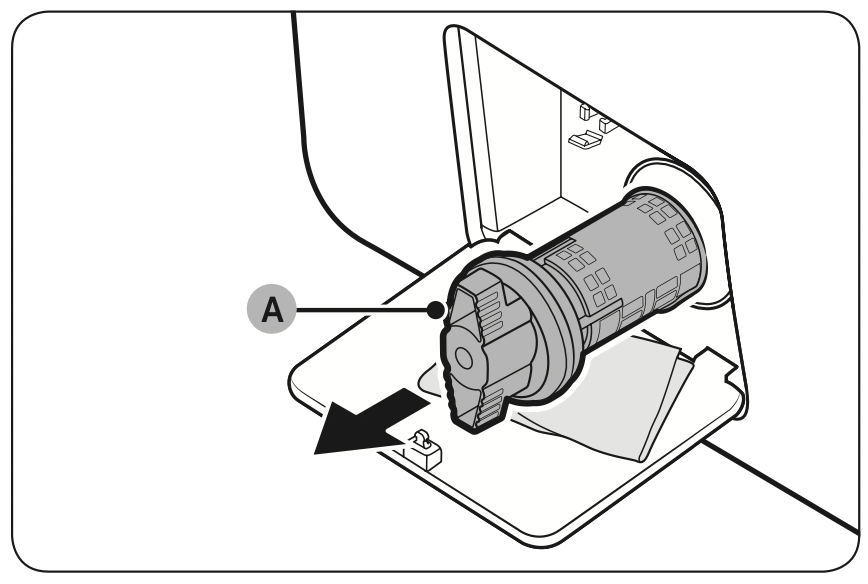
- Clean the pump filter using a soft brush.
Make sure the drain pump propeller inside the filter is not clogged. - Reinsert the pump filter, and then turn the filter knob clockwise.
- Close the filter cover.

NOTE
- Some pump filters feature a safety knob that is designed to prevent children from accidentally opening the filter compartment. To open the safety knob of the pump filter, push in and turn it counterclockwise. The spring mechanism of the safety knob helps open the filter.
- To close the safety knob of the pump filter, turn it clockwise. The spring makes a rattling sound, which is normal.
- Before closing the filter cover, make sure the pump filter is properly inserted.
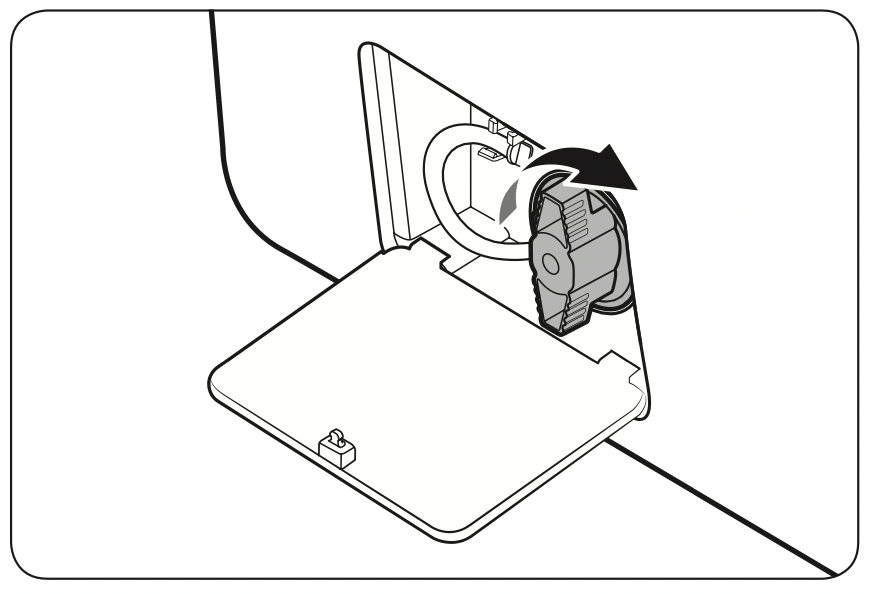
NOTE: If the pump filter is clogged, the “5C” information code appears on the washer’s display screen.
CAUTION
- Make sure the filter knob is closed properly after cleaning the filter. Otherwise, this may cause a leak.
- Make sure the filter is inserted properly after cleaning it. Otherwise, this may cause an operational failure or a leak.
Detergent drawer
- Open the drawer.
- While holding down the release lever (A), remove the drawer.
- Remove the liquid detergent container from the drawer.

- Clean the drawer components in running water using a soft brush.
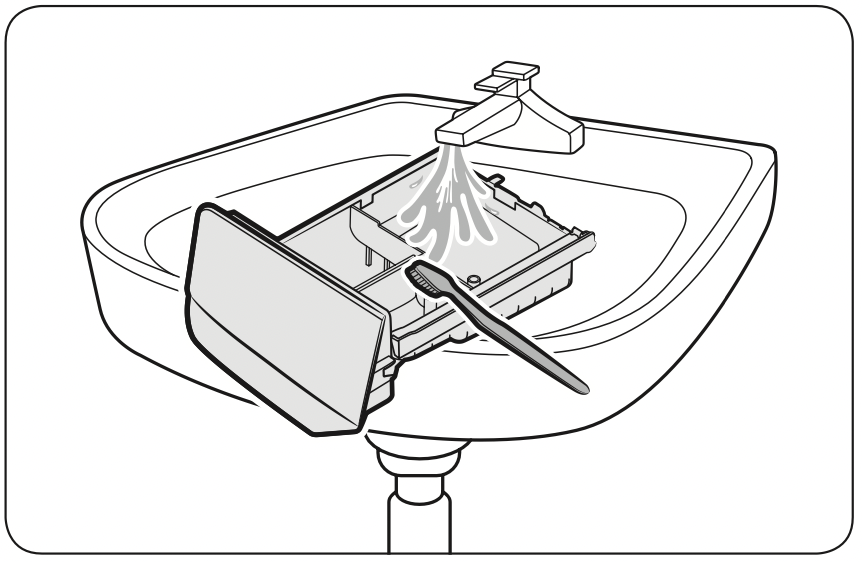
NOTE: Other parts of the drawer can also be removed. They can fall out if you hold the drawer upside down. - Clean the drawer recess using a soft brush.
- Reinsert the liquid detergent container into the detergent drawer.
- Slide the drawer into the drawer recess, and then push it inward until it is fully closed.

NOTE: To remove remaining detergent, run the RINSE+SPIN cycle with the drum empty.
Door diaphragm
- Open the door, and then empty the drum.
- Combine 3/4 cups of liquid chlorine bleach and 1 gallon of warm tap water.
- Wearing rubber gloves, use a soft, clean cloth dipped in the water and bleach solution to clean the diaphragm.
- Let stand 5 minutes, and then wipe up and dry well.
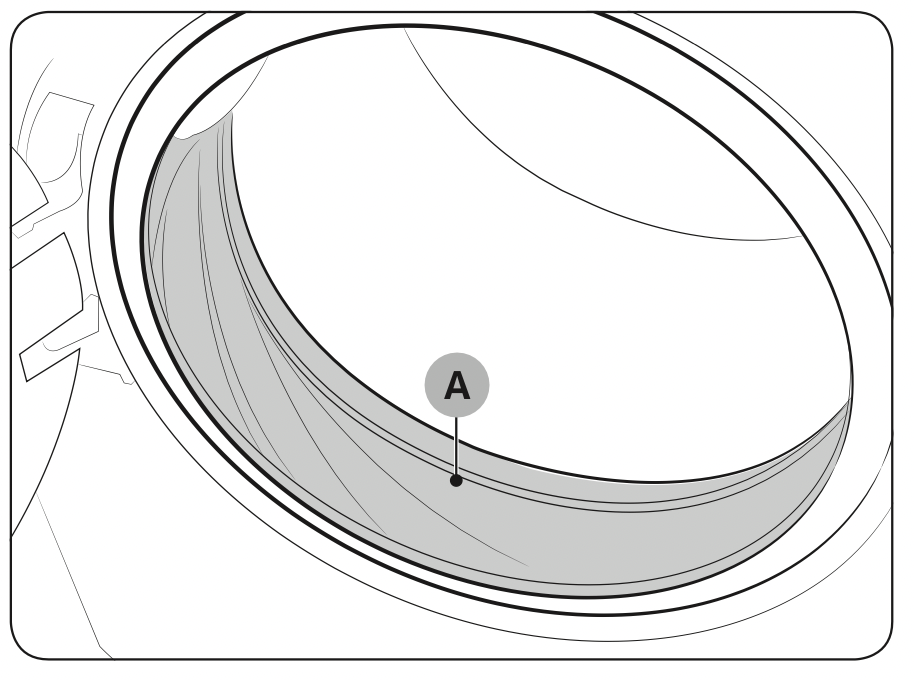
CAUTION: Use bleach carefully and be sure to follow the bleach manufacturer’s use and care instructions.
Recovery from freezing
The washer may freeze when the temperature in its location drops below 32 °F (0 °C).
- Turn off the washer, and then unplug the power cord.
- Pour warm water over the water tap to loosen the water hose.
- Disconnect the water hose, and then soak it in warm water.
- Pour warm water into the drum and leave it for about 10 minutes.
- Reconnect the water hose to the water tap.
NOTE: If the washer still doesn’t operate normally, repeat the steps above.
Care for an extended period of non-use
Avoid leaving the washer unused for an extended time. However, if you intend to leave the washer unused for a long period of time, follow the directions below:
- Press Power, and then turn the Cycle Selector to RINSE+SPIN.
- Empty the drum, and then press and hold Start/Pause (Hold to Start).
- When the cycle is complete, close the water taps and disconnect the water hoses.
- Turn off the washer, and then unplug the power cord.
- Open the door to let air circulate through the drum.
Cleaning the exterior
- Turn off the water taps after finishing the day’s washing.
This will shut off the water supply to your washer and prevent the unlikely possibility of damage from escaping water. Leave the door open to allow the inside of your washer to dry out. - Use a soft cloth to wipe up all detergent, bleach, or other spills as they occur. Clean the following as recommended below:
Control Panel – Clean with a soft, damp cloth. Do not use abrasive powders or cleaning pads. Do not spray cleaners directly on the panel.
Cabinet – Clean with soap and water.
Cleaning the interior
Clean the interior of your washer periodically to remove any dirt, soil, odor, mold, mildew, or bacterial residue that may remain in your washer as a result of washing clothes.
CAUTION: Failure to follow these instructions may result in unpleasant conditions, including odors and/or permanent stains on your washer or laundry.
NOTE: Hard water deposits may be removed, if needed. Use a cleaner labeled “Washer safe”.
Troubleshooting
Checkpoints
If you encounter a problem with the washer, first check the table below and try the suggestions.
|
Problem |
Action |
|
Does not start. |
|
|
Water supply is in sufficient, or no water is supplied. |
|
|
After a cycle, detergent remains in the detergent drawer. |
|
|
Excessive vibrations or makes noise. |
|
|
Does not drain and/ or spin. |
|
|
The door does not open. |
|
|
Excessive suds. |
|
|
Cannot add additional detergent. |
|
|
The washer stops. |
|
|
Fills with the wrong temperature water. |
|
|
The load is wet at the end of a cycle. |
|
|
Leaks water. |
|
| Has odors. |
|
|
After a cycle, washer is not off and/or the door does not open. |
|
If a problem persists, contact a local Samsung service center.
Information codes
If the washer fails to operate, you may see an information code on the screen. Check the table below and try the suggestions.
|
Code |
Action |
|
1C |
Check the water level sensor.
|
|
DC |
The door is open.
|
|
DC1 |
Check the door switch.
|
|
LC |
Check for water leaks.
|
|
4C |
Check the water supply line.
|
|
4C2 |
Laundry needs protection because the water being supplied is too hot.
|
|
5C |
Check the drain system.
|
|
HC |
Check the washing heater.
|
|
UB |
Check the spinning process.
|
|
8C, 8C1, 8C2 |
Check the MEMS sensor.
|
|
OC |
Water may overflow.
|
|
3C |
Check the motor.
|
|
AC6 |
Check the PBA communication status.
|
|
9C1, 9C2 |
The electronic control needs to be checked.
|
|
SF |
System failed.
|
If any information code keeps appearing on the screen, contact a local Samsung service center.
